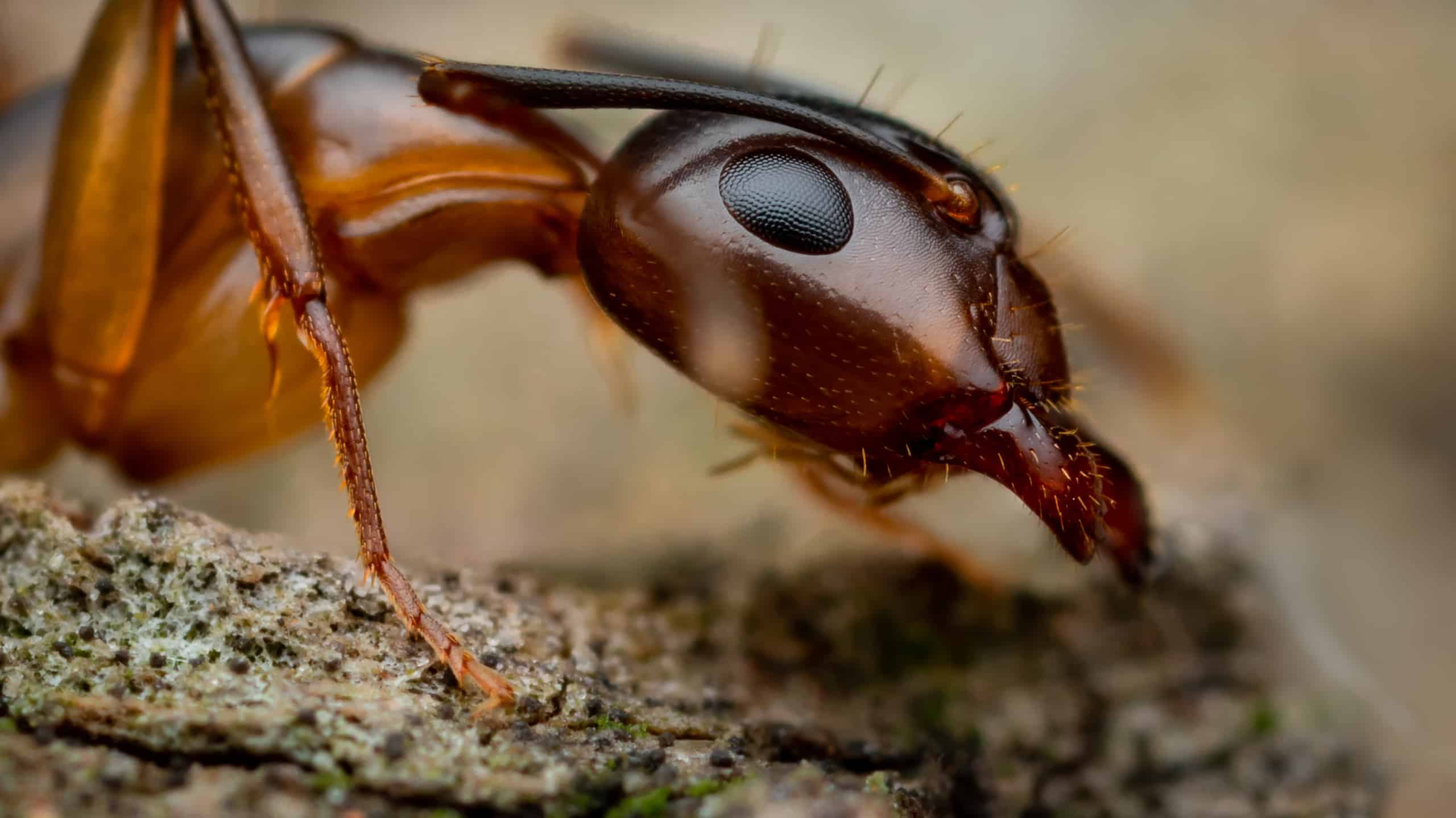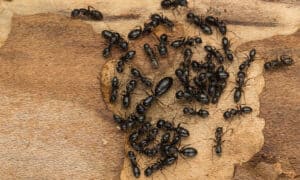Introduction
Alabama’s location within the United States makes it one of the states with the hottest summer in the entire country. The southern state has temperatures averaging over 90 degrees Fahrenheit (33 degrees Celsius) during most of the summer months. The temperatures are accompanied by high humidity levels that make the atmosphere muggy and warm. The temperature varies throughout different regions of the state. Some areas remain cooler due to elevation and ocean winds blown in from the Gulf of Mexico. The rising temperatures during summer months tend to increase ants’ body temperature. The rise in temperature makes them much more active than during other times of the year. Here are the seven types of ants set to emerge in Alabama this summer, and what to expect.
Dark Rover Ants
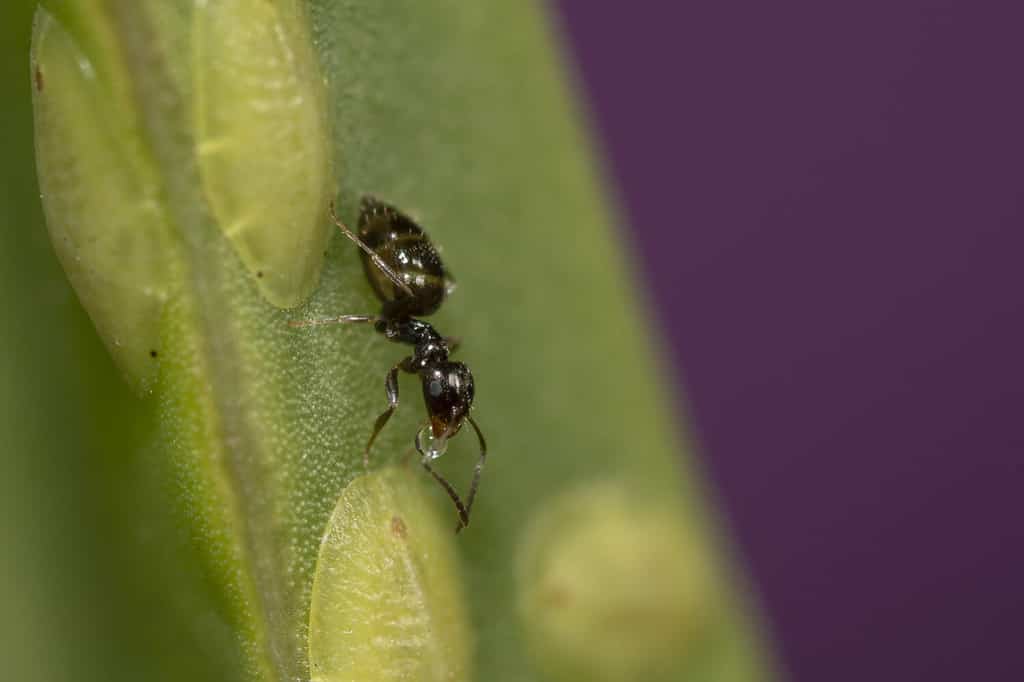
The dark rover ant, or brachymyrmex patagonicus Mayr, was introduced to the southern region of the United States relatively recently.
©Wirestock Creators/Shutterstock.com
The dark rover ant, or brachymyrmex patagonicus Mayr, was introduced to the southern region of the United States relatively recently. Native to Argentina and parts of Paraguay, the dark rover ant can be identified by its tiny brown body ranging from one to three millimeters in length. These ants can also be identified by their irregularly large eyes, long hairs on their mesosoma, and fairly sparse hairs on the surface of their gasters.
Dark rover ants build their colonies in the soil. They are often found at the bases of trees and underneath the cover of fallen leaves. These ants congregate in large colonies, with workers serving their queens to bring nutrients from plants such as cacti. Their large numbers can make them a nuisance. They invade highly populated areas and even build large colonies in the interiors of homes. These ants are most active during their mating season. They will have a noticeable emergence in Alabama during May, and begin to go back into hiding in late August.
Argentine Ants

Argentine ants are especially invasive due to their aggression towards other ant species.
©Victor Suarez Naranjo/Shutterstock.com
Native to Northern Argentina, the Argentine ant, or Linepithema humile, has become a globally distributed species that is often considered a nuisance. These ants have a light to dark brown color, measure between two to three millimeters in length, and have smooth, hairless bodies. They can be found building colonies in wet locations that are near a stable food source. They prefer the underside of boards and stones and along sidewalks.
Argentine ants are especially invasive due to their aggression towards other ant species, fighting for both food and territory. They form networks of nests that are interconnected, with around 15 queen ants for every 1,000 workers. This makes them populous and hard to control, and they can often be a nuisance in homes and neighborhoods. These ants begin to emerge during the late spring season. They will remain prevalent in the Alabama environment until early fall. They will be less noticeable during the fall and winter months. Natural phenomena such as winter rainstorms can cause them to re-emerge outside of their mating season.
Pharaoh Ants
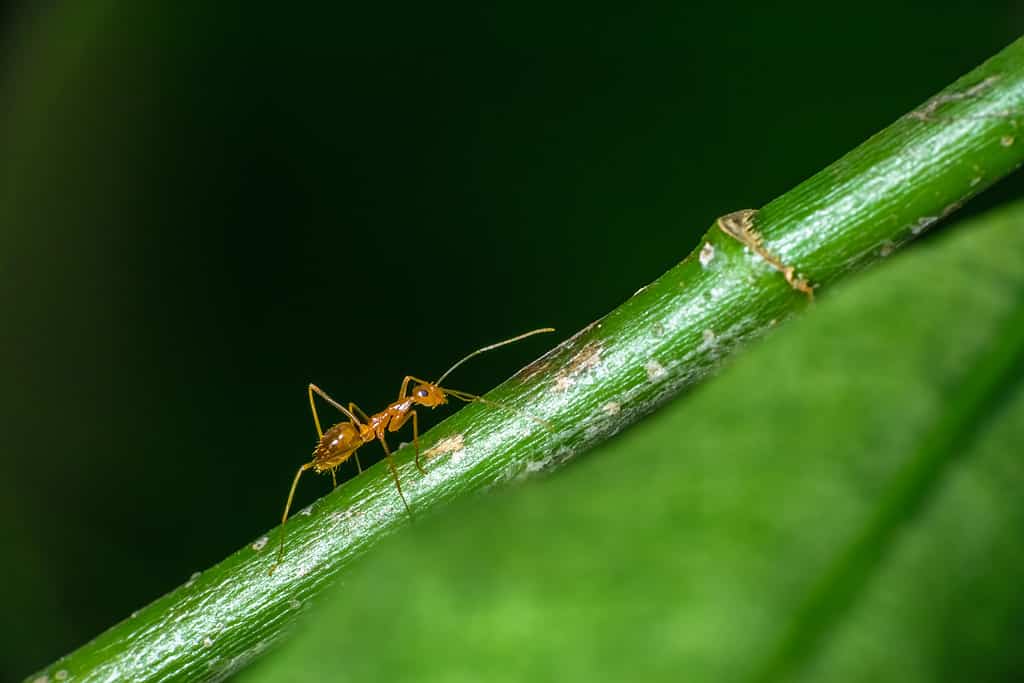
Pharaoh ants most commonly nest in warm areas with high humidity and proximity to a stable food source.
©iStock.com/Suman Ghosh
Often distinguished as the most difficult house ant to control, the pharaoh ant, or Monomorium pharaonis, is native to Africa. They have since been disturbed throughout many locations around the globe. Pharaoh ants measure between one-and-a-half to two millimeters in length and have fairly hairless bodies. These ants range in color from a yellowish-light brown to red, with abdomens that are noticeably darker than the rest of their bodies. Colony sizes vary greatly. Some colonies are as small as a few dozen ants and others grow up to 1,000 in number.
Pharaoh ants most commonly nest in warm areas with high humidity and proximity to a stable food source. This species of ant is especially invasive due to the creation of many new colonies from a singular mother colony. Their prolific nature allows for the distribution and size of the pharaoh ant population within a specific area. These ants are known for building their nests in indoor areas. Pharaoh ants are incredibly skilled at breaking into food supplies and sealed-off spaces. They are extremely difficult to remove. These ants concentrate around scarce heat sources during the fall and winter months. They emerge to more spread-out locations around homes and other buildings during the spring and summer seasons to reproduce and collect food.
Odorous House Ant
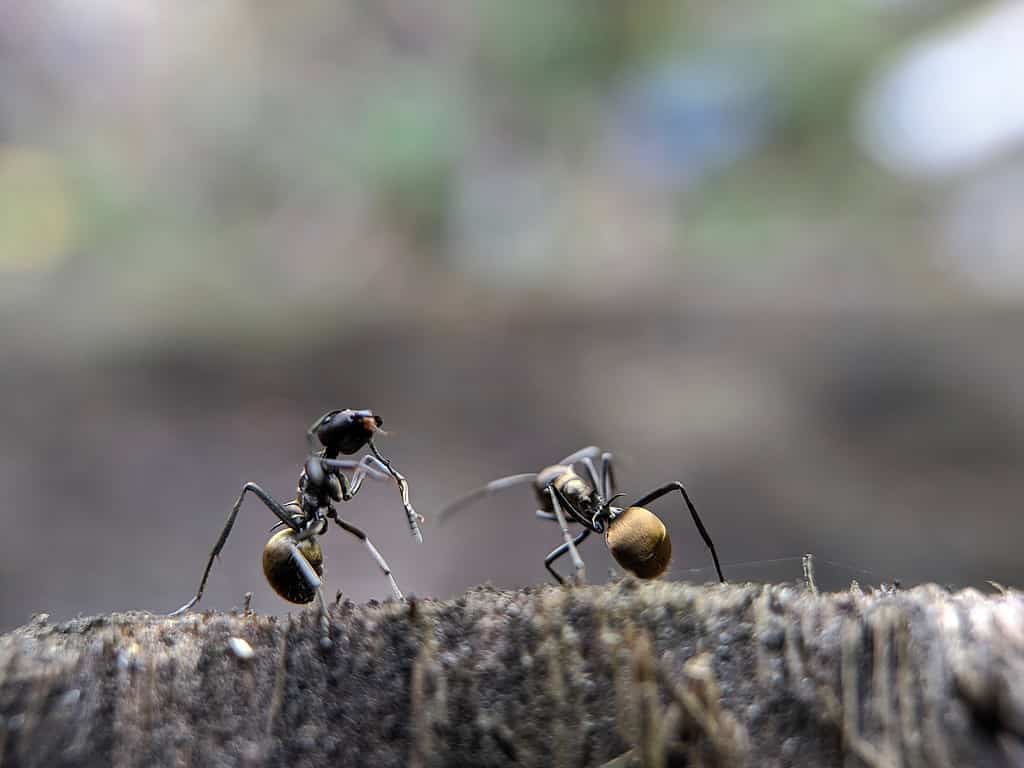
Odorous house ants get their name from the distinct odor they exude.
©Dhe Tong/Shutterstock.com
Most commonly found in the United States as well as parts of Canada and Mexico, the odorous house ant, or Tapinoma sessile, is a very unique type of ant. These ants measure around three millimeters in length and range in color from dark brown to black. They have a one-segmented middle section that has a flat node hidden by their abdomen, which hangs over the top of it.
Odorous house ants get their name from the distinct odor they exude. When crushed, they often smell like rotten coconut. This distinguishable feature makes them easy to identify when they have invaded indoor spaces such as homes, restaurants, or office spaces. These ants are often found living within homes and in preexisting outdoor shelters such as the undersides of logs, piles of straw, and doghouses. Once temperatures increase during mid-March, these ants begin to emerge from their colonies to forage for more food and continue the mating cycle. They will remain fairly active in Alabama until temperatures begin to cool again in October.
Pavement Ant

They can be found nesting underneath sidewalks in more suburban areas, which is where they get their name.
©Ernie Cooper/Shutterstock.com
The pavement ant, or tetramorium caespitum, is an extremely common ant found throughout the United States that originated in Europe. These ants usually are around three millimeters long, and have a dark brown to black coloring. They have indented streaks called striations covering their heads and thorax, and 12-segmented antennae that protrude from their heads.
Pavement ants are usually found living outside in large open fields underneath natural shelters such as rocks and logs. They can also be found nesting underneath sidewalks in more suburban areas, which is where they get their name. Their colonies can grow to massive sizes upwards of 10,000 ants. They often have numerous queens guiding the workers to collect food and continue to grow the population. These ants are predominately outdoor insects but can become pests when they invade homes in search of food and sweets. They usually emerge during the early spring months. The ants remain active foraging during the daytime throughout the summer months into early fall. These ants often fight other colonies on the pavement during the summer, which makes them especially noticeable.
Black Carpenter Ant
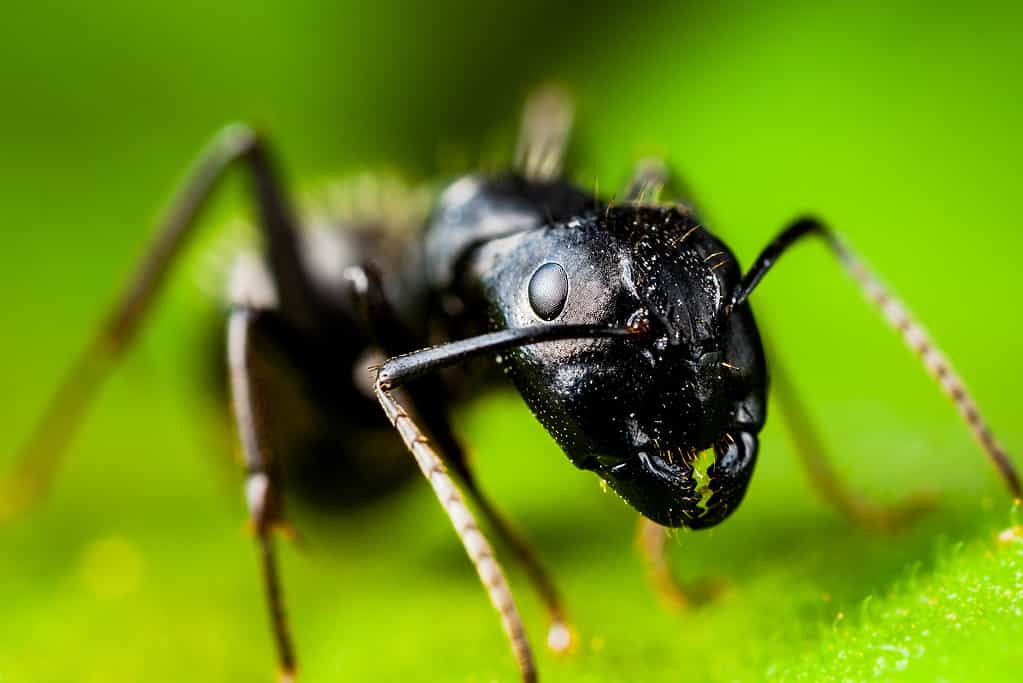
Black carpenter ants get their name for their unique characteristic of chewing through the wood to create nests.
©Denis Vesely/Shutterstock.com
The black carpenter ant, or Camponotus pennsylvanicus, is the most common type of carpenter ant in the world. These ants occur naturally throughout the United States and were the first North American ants to be identified and named. Black carpenter ants range from six to 12 millimeters in length and have an entirely black body that is decorated with fine white and yellow hairs on the abdomen. They have a singular node separating their abdomen and an evenly rounded, arched thorax that helps distinguish them from other ant species.
While other ants build their nests in soil and warm, wet areas, black carpenter ants get their name for their unique characteristic of chewing through the wood to create nests. They use their strong jaws, called mandibles, to clear out areas in the wood for nesting, but do not consume the wood like termites. As temperatures increase, black carpenter ants become more active during late March and early April and continue to emerge until late September when temperatures drop again and the fall season begins.
Tawny Crazy Ant
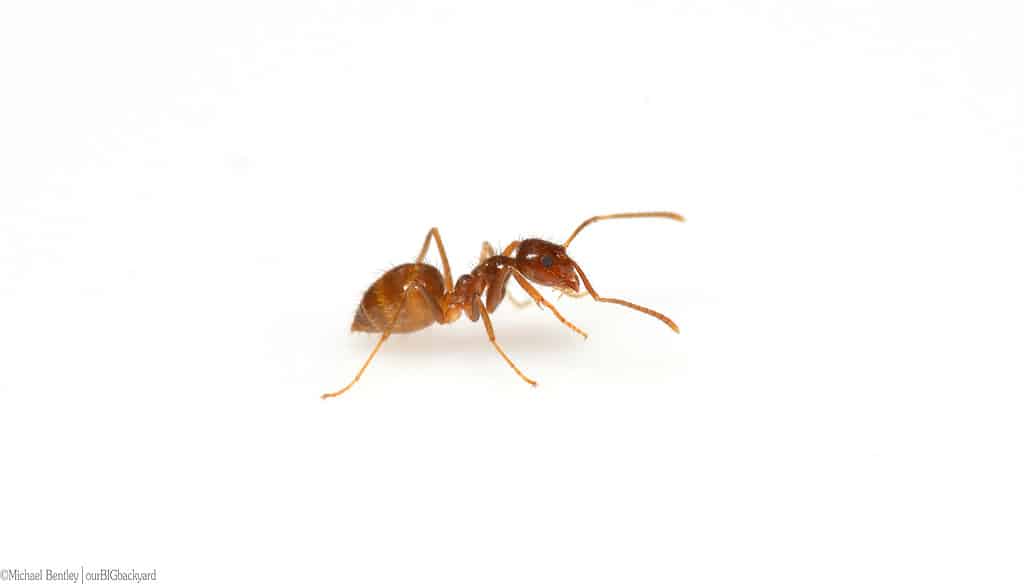
These ants are usually found living underneath stones and various stick piles in places that are warm and humid.
Also known as the raspberry crazy ant, the tawny crazy ant, or Nylanderia fulva, is originally from South America but has since spread to many areas around the globe including the Southern United States. They got their nickname from Texan exterminator Tom Raspberry, who began to notice them as a nuisance in the early 2000s. Tawny crazy ants measure around three millimeters in length and have reddish-brown bodies with black abdomens. They are covered in red hairs, giving them a distinct color that sets them apart from other ants.
These ants are usually found living underneath stones and various stick piles in places that are warm and humid. Tawny crazy ants can be a pest due to their ability to chew through electrical equipment such as wires and cause short circuits and other issues within residential and professional buildings. As soon as the warmer spring weather arrives, these ants begin to emerge and grow steadily in population, finding new places to nest around food sources and hot areas maintained by the summer heat. They continue to run rampant until temperatures decrease in late September, sending them back into hiding to stay warm.
Other Insects Set to Emerge in Alabama
The hot summer weather causes many insects to become more active during the season than just ants. Other insects set to emerge include bedbugs, which are reddish-brown insects measuring roughly one to seven millimeters in length. They can be identified by bite marks on various parts of the body, as well as being found in the folds of bedsheets. Wasps will also emerge beginning in the spring along with termites and many different species of house spiders such as brown recluses and black widows. All of these insects become most active during the summer months and will begin to disappear as the temperature drops again in the fall.
Thank you for reading! Have some feedback for us? Contact the AZ Animals editorial team.

